A cottage garden is more than just a collection of flowers—it’s a whimsical, charming space that brings together rustic charm and natural beauty. It’s the kind of cottage garden design that makes you want to spend hours admiring the delicate blooms, the calming sound of water, and the peaceful atmosphere it creates.
If you’re looking to transform your outdoor space into a picture-perfect retreat, this article offers 19 fantastic ideas to bring your cottage garden design to life. These tips will help you create a low-maintenance garden that feels natural, inviting, and brimming with life.
1. What Sets Cottage Gardens Apart?
A cottage garden is typically characterized by a relaxed and informal design. Unlike the more structured English gardens, cottage gardens prioritize a whimsical and wild aesthetic that embraces the beauty of nature in its raw form. The focus is on blending a variety of plants—both edible and ornamental—without strict organization.
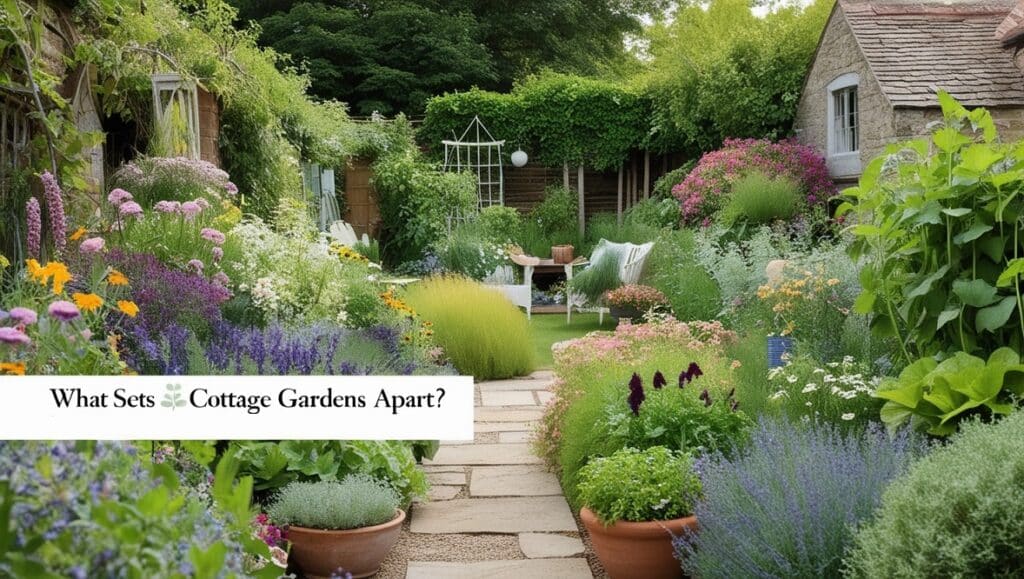
Key Differences Between Cottage and English Gardens:
- Cottage Gardens: Informal, wild, and often overflowing with plants.
- English Gardens: More formal and controlled with straight lines, symmetry, and neat plantings.
In a cottage garden, you’ll find plenty of flowers, herbs, and vines—all coming together to create a naturalistic setting. The goal is to celebrate the unexpected beauty found in nature.
2. Best Plants for Cottage Gardens
Choosing the right plants is critical to achieving the look of a traditional cottage garden.
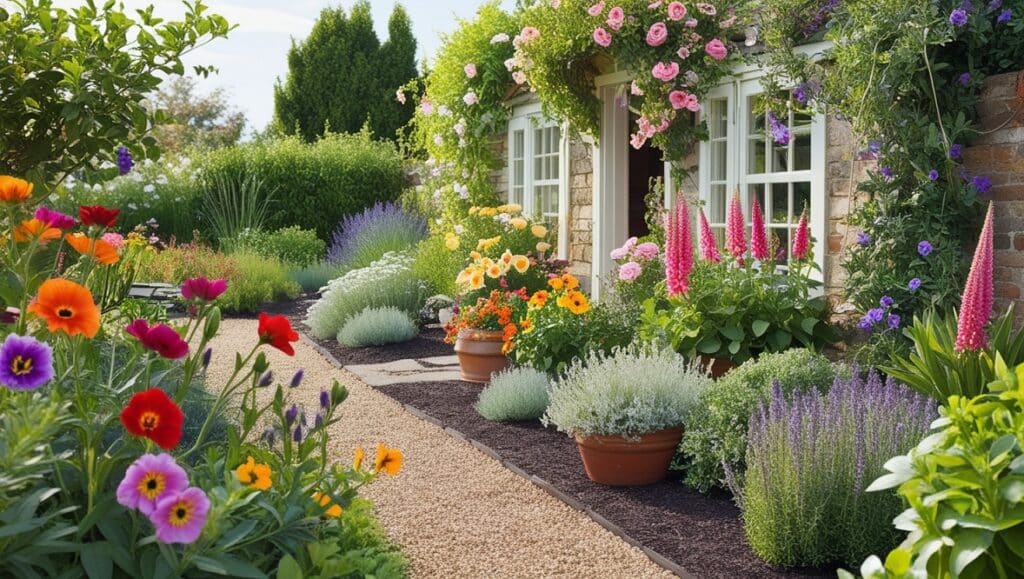
Here are some plant categories and examples to help you get started:
- Perennials: These plants come back every year, providing lasting color and structure. Examples include lavender, peonies, daylilies, and black-eyed susans.
- Flowers: Bright and cheerful blooms are a must. Think roses, poppies, daisies, and foxgloves.
- Vines: Climbing plants add vertical interest and help frame entrances or fences. Consider clematis, honeysuckle, or wisteria.
- Herbs: Herbs like mint, thyme, rosemary, and sage not only add texture but also serve as edible delights.
- Ground Covers: Low-growing plants that cover the soil and reduce weeds, such as creeping thyme or clover.
Planting Tip:
Mix annuals and perennials for a garden that offers color throughout the seasons. Annuals like zinnias and geraniums will bloom throughout the warmer months, while perennials like lilies and lavender return year after year.
3. Add an Arbor for a Cozy Entrance
An arbor is a charming addition that brings height and structure to your cottage garden. These garden structures are often used to frame entrances, creating a warm and welcoming path.

Arbors are perfect for supporting climbing plants like roses or grapevines, and they provide a peaceful spot to pause as you enter your garden.
Benefits of Adding an Arbor:
- Adds a focal point to the entrance.
- Provides support for climbing plants.
- Frames pathways and creates a sense of intimacy.
4. Incorporate a Garden Bench for Relaxation
What’s a cottage garden without a place to sit and enjoy the beauty around you? A garden bench is not just practical; it also adds character to the space. Whether made of wood, wrought iron, or stone, a bench creates a peaceful spot for relaxation.
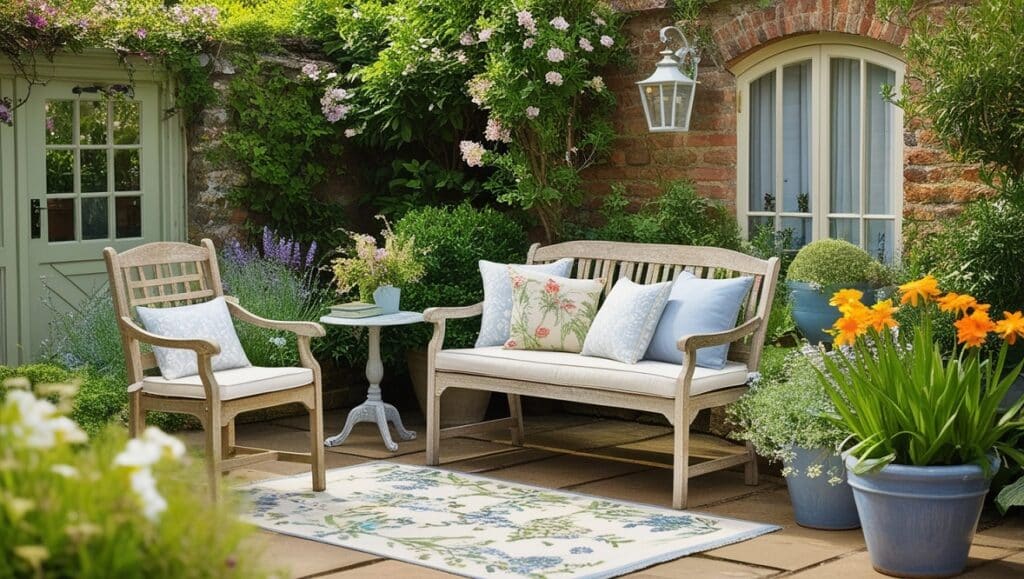
Choosing the Right Bench:
- Wooden Benches: Rustic and natural, they blend well in any cottage garden.
- Iron Benches: Elegant and vintage, they can add a formal touch while still fitting into the casual design of a cottage garden.
Tip: Place the bench near fragrant flowers like lavender or roses to enhance the relaxing experience.
5. Lay a Pathway to Guide the Way
Paths are essential for leading visitors through your cottage garden, creating an inviting journey. Whether made from gravel, stone, or wood, a well-placed path provides a sense of purpose and flow. It can also help define different sections of your garden.
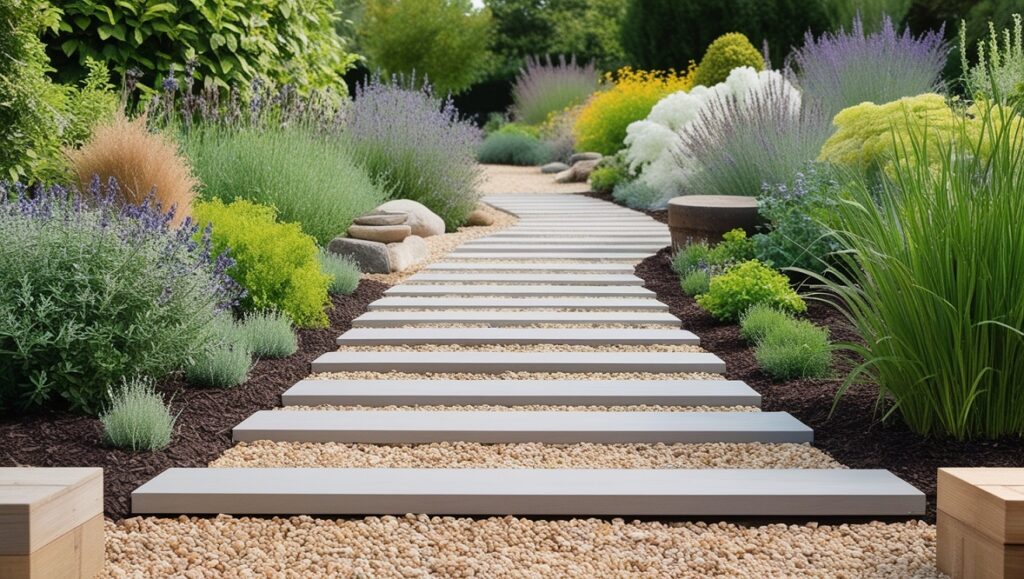
Path Materials:
- Gravel: Casual and rustic, perfect for creating a natural look.
- Stone: Adds texture and stability, great for a more structured look.
- Wooden Planks: Ideal for a DIY project that blends with the natural elements of your garden.
Paths are both functional and aesthetic, guiding you from one beautiful spot to the next.
6. Attract Birds with a Birdbath
A birdbath is a simple yet effective way to attract pollinators and birds into your garden. It’s a wonderful feature for a cottage garden, offering a bit of elegance and a place for birds to drink and bath.

Tips for a Birdbath:
- Placement: Choose a spot in partial shade to keep the water cool.
- Material: Stone or ceramic birdbaths are classic choices, but any weather-resistant material will do.
Bonus: Adding a birdbath also helps with wildlife conservation, supporting bees, butterflies, and other important pollinators.
7. Create Movement with a Water Fountain
A water fountain introduces soothing sounds into your garden, making it feel more peaceful and alive. Whether you go for a small tabletop fountain or a grander design, the gentle sound of running water enhances the tranquil vibe of a cottage garden.
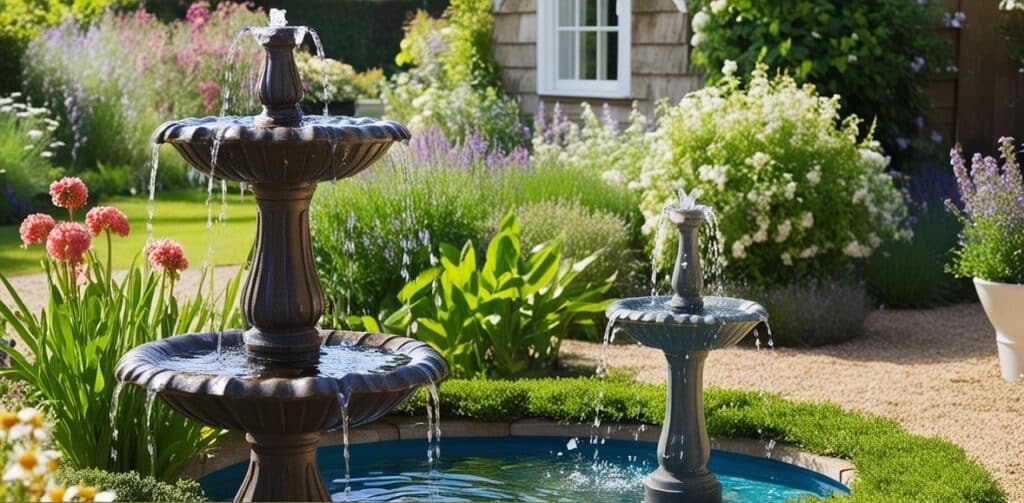
Types of Fountains:
- Freestanding Fountains: A beautiful addition that serves as the garden’s focal point.
- Wall Fountains: Great for smaller spaces, they offer a vertical element while conserving space.
A water fountain not only adds charm, but it also attracts pollinators like bees and butterflies, adding more life to your garden.
8. Create a Focal Point with Sculptures or Statues
Every cottage garden needs a focal point—something to draw the eye and give the space a sense of balance. A sculpture, statue, or even a birdbath can be the perfect piece to create this.

Ideas for Focal Points:
- Rustic Statues: Think of fairytale-inspired animals or garden gnomes.
- Sculptures: Abstract or nature-inspired sculptures bring artistic flair.
- Trellis with Climbing Vines: A lovely focal point that’s both functional and beautiful.
9. Grow an Array of Blooms in Varying Heights
Cottage gardens thrive on an abundant mix of flowers. To achieve this, layer plants by height: place the tallest plants at the back of the garden and the smaller ones at the front. This creates a visually appealing, layered effect that adds dimension to your garden.

Plant Layering:
- Tall Plants: Hollllyhocks, delphiniums, and lupines.
- Mid-Height Plants: Peonies, daisies, and hydrangeas.
- Short Plants: Pansies, petunias, and lavender.
10. Grow Herbs in Pots for Convenience and Charm
Herbs are perfect for adding fragrance and flavor to a cottage garden. Growing them in pots not only makes them easy to maintain, but it also adds an extra layer of visual interest. Herbs in pots can be placed throughout your garden or on a sunny patio.

Popular Herb Pots:
- Lavender: A classic cottage garden herb.
- Thyme: Versatile and easy to grow.
- Basil: Great for cooking and offers a burst of color.
11. Incorporate a Pergola for Vertical Appeal
A pergola is one of the most classic elements you can add to a cottage garden. It provides vertical height, offering a nice contrast to the low-growing plants that dominate most gardens.

Pergolas are especially useful for supporting climbing plants, such as wisteria, clematis, and honeysuckle, which can create an ethereal canopy of blooms that draw the eye upward.
How to Use a Pergola:
- Climbing Vines: Add climbing plants like roses or grapevines to create a beautiful, fragrant overhang.
- Seating Area: Position your pergola near a seating area, and use it to create a shaded retreat in the garden.
- Decorative Elements: Hang string lights, vintage lanterns, or garden decorations like wind chimes to make your pergola even more inviting.
A pergola is not just functional; it’s also a great way to add a striking focal point in your cottage garden that elevates the overall design. This structure blends beautifully with the rustic and whimsical qualities typical of a cottage garden, allowing you to enjoy nature from beneath its shaded canopy.
12. Plant Along a Picket Fence for a Classic Look
The picket fence is often associated with a classic cottage garden design, evoking images of quaint homes surrounded by lush greenery and colorful flowers. A wooden picket fence helps define the edges of your garden, creating boundaries while maintaining an open, airy feel.

By planting climbing vines or shrubs along the fence, you can soften its appearance and enhance its rustic charm.
How to Enhance Your Picket Fence:
- Climbing Roses: Let roses climb along the fence for an elegant, timeless look.
- Morning Glory Vines: These fast-growing vines offer a burst of color and vibrant blooms.
- Hops: If you want a more rustic, cottage feel, hop vines can be an excellent choice for covering your fence.
- Succulent Shrubs: Small succulents or herbs can be planted at the base of the fence, adding texture and a pop of greenery.
The picket fence not only enhances the visual appeal of your cottage garden but also supports vertical gardening, which is a great way to maximize space and add variety to your garden design.
13. Cover the Soil with Mulch or Ground Cover
Mulch is an essential part of creating a low-maintenance cottage garden. It helps retain moisture, suppress weeds, and improve the soil’s texture. Using mulch also gives your garden a tidy, well-kept appearance while providing your plants with the nutrients they need to thrive.

Best Types of Mulch:
- Wood Chips: A traditional and natural-looking mulch that adds a rustic charm to your garden.
- Bark Mulch: Great for creating a natural, woodland feel in your garden.
- Straw Mulch: This is a good option if you’re growing vegetables or herbs since it is easy to work with and provides good insulation for plants.
- Leaf Mulch: Made from fallen leaves, this mulch decomposes quickly and adds organic matter to the soil.
Alternatively, ground covers such as creeping thyme or sedum can also act as mulch. These plants are low-growing, helping to cover the soil while adding texture and color to the garden.
Their sprawling nature is perfect for filling in spaces between your flowers, helping to create a seamless, natural look.
14. Make a Statement with Stone Planters
Stone planters are a beautiful and practical addition to any cottage garden. These sturdy containers can hold flowers, shrubs, or even herbs, and they add an elegant touch to your garden’s design.

Stone planters come in various shapes and sizes, and they work well both in the garden beds and as standalone features in corners or along pathways.
Benefits of Using Stone Planters:
- Durability: Stone planters are weather-resistant and can last for years without needing replacement.
- Texture: Stone offers a tactile and visual contrast to the soft flowers and herbs in your garden.
- Height: By placing planters on elevated surfaces, you can add vertical dimension to your garden, which helps create visual depth.
Place a few stone planters along a pathway, near a focal point, or at the base of your arbor to add sophistication and texture to your space.
15. Mix Annuals and Perennials for Continuous Color
One of the key elements of a cottage garden is the variety of plants, and mixing annuals and perennials ensures your garden stays vibrant throughout the year. Annuals bloom for a single season, offering bright bursts of color, while perennials come back year after year, providing reliable structure and beauty.

Popular Annuals for Cottage Gardens:
- Petunias: These flowers come in vibrant colors and bloom all summer long.
- Geraniums: Known for their bold colors and easy-care nature, they make a great addition to any cottage garden.
- Marigolds: Their sunny yellow and orange flowers add a cheerful touch.
Popular Perennials for Cottage Gardens:
- Lavender: This fragrant herb is a must-have in a cottage garden for its beautiful blooms and calming scent.
- Black-Eyed Susans: These plants offer bright yellow flowers that are a staple in many cottage gardens.
- Shasta Daisies: Their white petals and yellow centers provide a classic, nostalgic look.
By mixing these plants together, you’ll create a garden that offers color, texture, and charm throughout the seasons. Consider planting annuals in the front of your garden and perennials in the back to create a layered, balanced design.
16. Add Whimsical Touches with Painted Pots
A cottage garden is all about personality, and one of the easiest ways to infuse some fun into your garden is by incorporating painted pots. Brightly colored or uniquely decorated planters can bring a playful, whimsical element to your space, complementing the natural beauty of your flowers and plants.

Ideas for Painted Pots:
- Pastel Colors: Soft pinks, blues, and greens work well in cottage gardens, creating a calm, soothing atmosphere.
- Bold Patterns: Stripes, polka dots, or even floral designs can add a fun, creative touch.
- Rustic Finishes: Use chalk paint or distressed finishes for a more rustic, vintage vibe.
Painted pots can be used throughout your garden—on the pergola, near the focal point, or along garden paths—and they work particularly well with herbs or annuals.
17. Let Your Garden Be a Haven for Pollinators
Creating a pollinator-friendly garden is not only beneficial for the environment, but it also helps your garden thrive. Bees, butterflies, and other pollinators are crucial for the health of many plants, and by planting specific flowers and shrubs, you can attract these important creatures to your garden.

Pollinator-Friendly Plants to Include:
- Coneflowers: These hardy perennials attract bees and butterflies.
- Sunflowers: Their large blooms are a favorite for bees.
- Lavender: Known for attracting bees with its strong fragrance.
Incorporating a birdbath or water fountain into your garden will also help attract other pollinators, including birds, that play a crucial role in your garden’s ecosystem.
18. Build a Rustic Gate for Added Charm
A rustic gate is the perfect way to create an inviting entrance to your cottage garden. Made from weathered wood or metal, it adds an instant sense of character to the garden while complementing the rustic style of your outdoor space.

Ideas for Your Rustic Gate:
- Wooden Gates: Weathered wood gives a vintage, worn look that fits perfectly with a cottage garden.
- Arched Gates: An archway-style gate enhances the whimsy and natural flow of the garden.
- Decorative Hardware: Adding vintage hinges or a wrought-iron handle can further emphasize the gate’s rustic charm.
A rustic gate helps define the entry to your garden while welcoming visitors into the serene space beyond.
See also 27 Rustic Fireplace Mantel Decorating Ideas for All Seasons
19. Use Color to Brighten Up the Space
Color is a vital part of cottage garden design, whether it’s in the flowers, the furniture, or the accessories. By playing with color, you can create a garden that feels cheerful, inviting, and full of life.

Ways to Incorporate Color:
- Flower Beds: Plant a mix of bright and pastel blooms to create visual interest.
- Furniture: Use vibrant chairs or tables made from weathered wood to add pops of color.
- Painted Pots: As mentioned earlier, painted pots can bring a playful element to your garden.
Color Combinations:
- Pink and Yellow: A classic combination that brings warmth and cheerfulness.
- Purple and White: Elegant and calming, this pairing works well for a more structured garden.
- Red and Orange: Bold and striking, this color scheme adds energy and vibrancy.
By mixing colors throughout your cottage garden, you’ll create a vibrant and visually appealing space.
Conclusion
By blending classic elements with your personal style, your cottage garden can become a peaceful retreat full of beauty, texture, and charm. Whether it’s adding a rustic gate, planting pollinator-friendly flowers, or creating whimsical touches with painted pots, each element you introduce contributes to the garden’s overall appeal.
Keep these tips in mind, and you’ll have a delightful cottage garden that’s sure to attract visitors and pollinators alike!

Max William, the expert behind Home Fabo, specializes in home decorating, blending creativity with practical design solutions. With years of experience in transforming spaces, Max shares innovative tips, stylish ideas, and DIY techniques to help readers elevate their homes with ease and elegance.